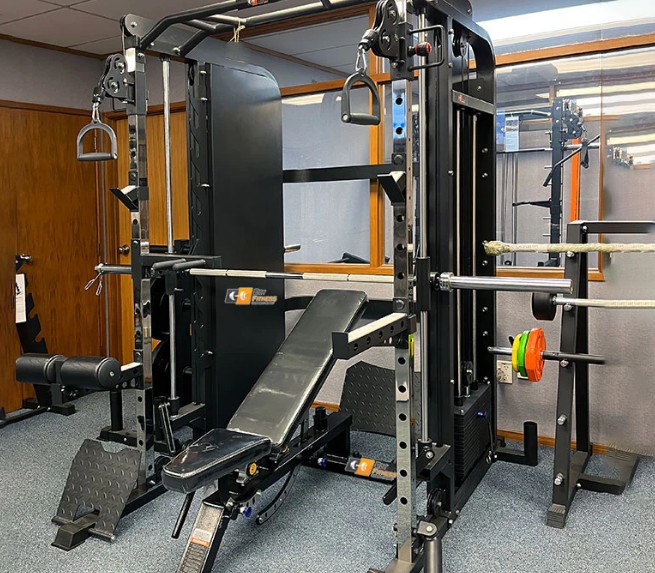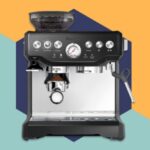Without a doubt, one of the most contentious leg exercises a lifter can perform on a Smith machine is the squat. In some gyms, it carries a stigma that is worse than the combined stigma of sweating on the equipment and curling in the squat rack.
Though it doesn’t necessarily follow that you shouldn’t. It continues to be one of the best Smith machine exercises available.
In fact, when performed correctly, a Smith machine squat will give your quads and glutes a serious muscle boost. Additionally, if muscle growth is your primary objective, you may sometimes see faster results than with the barbell version.
Smith Machine Squat Overview
The Smith machine squat is a form of the squat that is used to strengthen the leg muscles. The quads will be given a lot of attention, especially during the Smith machine squat.
By using a Smith machine, you can guarantee that the bar path stays fixed, which reduces the amount of stabilization required during the exercise.
The Smith machine squat can be incorporated into your leg exercises or full-body exercises.
Smith Machine Squat Instructions
- Place the safety stops just above knee height and the bar at a height just below shoulder.
- Put your pinkies on the barbell’s shiny ring.
- Position yourself at the bottom of your traps with your head straight ahead while getting under the bar.
- To take the safety hooks off the bar, unrack it by rotating your wrists.
- Inhale deeply and maintain a straight torso and elbows.
- Push the hips back while simultaneously bending the knees to descend.
- Drive your feet into the ground and flex your quads to reverse the movement once your thighs are parallel to the floor.
- As you fully extend your knees and hips to complete the lift, exhale.
Tips To A Smith Machine Squat
- The Smith Machine’s bar should be adjusted so that it is at shoulder level. In the end, the height will vary from person to person, and you might need to raise or lower it.
- Set up a loaded bar; 10-pound plates on each side make a great foundation. When starting out, beginners should only use the bar; as they gain experience with the movement, they can gradually add weight.
- Place your hands on the bar with about shoulder-width apart, and gently take an overhand grip.
- The muscles closest to your neck and upper back, the trapezius, are where you should place the bar as you step in front of the rack.
- Unlock the bar by lifting it up and forward while keeping your feet about hip distance apart.
- Put more weight into your heels this time. As you start to lower into a squat, brace your abs while maintaining a neutral spine and head position. The closest angle possible between your knees should be 90 degrees. Hold for one second.
- Drive through your heels to stand back up while keeping your core tight. At the peak of your squat, remember to squeeze your glutes. That’s one rep.
- Finish three sets of 12 repetitions.
Read More: How Much Does Bar Weigh on a Smith Machine?
How To Do Squats On A Smith Machine
Here’s the proper way to do squats on Smith machine stations:
Step 1 — The Setup
- The Smith bar should be placed at shoulder height, and you should then take a shoulder-width stance and stand underneath it so that the barbell rests on your upper traps.
- As you squeeze your upper back muscles to maintain proper core tightness, begin by grasping the bar with a shoulder-width grip.
- By extending your hips, you can unrack the bar. Next, flare your feet outward by 15 to 30 degrees. The more foot flare you want, the longer your legs should be.
- Keep your feet closer to your center of gravity to increase the tension on your quads, or move them out in front of the Smith machine to engage more glutes.
- Make sure your eyes are straight ahead and that your spine is in neutral.
- Instead of pointing your elbows straight down, bend them slightly back to prevent the resistance from passing through your joints.
- You’re now ready to squat.
Step 2 — The Descent
- Breathe deeply into your diaphragm and then tighten your abdominal muscles against your lifting belt.
- In order to descend, bend at the hips and knees at the same time [2]. As you descend, push your knees out slightly.
- Maintaining a neutral spine and heels that are grounded, squat as far as you can comfortably.
Step 3 — The Ascent
- As you would if you were attempting to leg press the gym floor, finish the rep by pressing your feet into the ground.
- To get past the sticking point, hold your breath until you’re about two thirds of the way up.
- Anywhere between 5 and 20 reps should be performed for 3-6 sets.
- Smith machine squat mistakes
- When performing the squat Smith machine style, avoid making these 4 terrible mistakes.
While performing a half squat on a Smith machine while using all the weight plates in the gym may temporarily boost your ego, it won’t do much for your legs. In fact, studies show that deep squatting, where your hips break parallel, results in 7% more muscle growth in just 12 weeks.
And what’s even better is that deep squatting isn’t any worse for your knees than parallel or above squatting.
But do you know what is bad for your knees?
During any quad-focused Smith machine back squat, some forward knee travel is unavoidable. Don’t go overboard with it, though. It is suicide for the long-term health of your knees to force your knees over your toes in an effort to increase range of motion or quad stimulation [4].
Instead, take a step away from the Smith machine and only allow a small amount of forward knee travel to increase the range of motion at your hips. Your knees will appreciate your much-improved strength.
Read More About Smith Machine:
- Can You Do Deadlift On A Smith Machine?
- How Much Does Bar Weigh on a Smith Machine?
- How Much Does The Smith Machine Bar Weigh?

Smith Machine Squat Benefits
Fewer Injuries
The use of Smith machine systems for your squats is a genius way to lower your risk of injury (especially when paired with a good pair of knee sleeves).
In contrast to barbell squats, Smith machine squats allow you to re-rack the bar at any point during the rep with just a flick of the wrist. As a result, it’s virtually impossible to be pinned beneath the bar, which, in my experience, gives you the confidence to exert more effort.
More Confidence
Undoubtedly, having strong legs boosts your confidence, particularly when you’re wearing shorts. But the kind of confidence that I’m talking about here is the confidence to push yourself to the limit, and thus, build muscle faster.
In other words, using Smith machine systems allows you to squat safely knowing that the spotter catches will always have your back. You can push yourself harder and build more defined legs as a result because you are confident that you can quickly re-rack the barbell.
Better Muscle Stimulation
Changing your foot position while performing a regular squat will result in a loss of balance. You can adjust your feet’s distance from one another, sure, but you can’t actually move your feet forward or backward without wobbling.
Targeting the precise muscles you want to work can be extremely frustrating as a result. For this reason, many people choose leg presses over squats because they can easily emphasize different muscles with a quick change in foot position.
If you have good mobility, of course, Smith’s machine squats are similar to leg presses in this regard except that you can achieve a much wider range of motion.
In contrast to free weight squats, Smith squats give you the option of positioning your legs out in front to concentrate on your glutes or keeping them close to your body to increase the tension on your quads.
How Does It Compare?
Similar to a leg press, a Smith machine barbell squat allows you to freely adjust your foot position to emphasize different muscle groups.
It goes without saying that a leg press enables you to lift much more weight than any squat, not even half squats!), and more weight usually means more muscle growth.
However, compared to the Smith machine squat, the typical leg press machine offers a much smaller range of motion. And as is common knowledge, achieving a full range of motion (i.e. using good form) is just as, if not more important for muscle growth than lifting heavy weights.
So, in general, I’d say that things are fairly equal. However, it also involves fewer of your core muscles than the leg press, which does offer more back support. I suggest trying both to determine which offers the best muscle stimulation and the least amount of joint discomfort.











